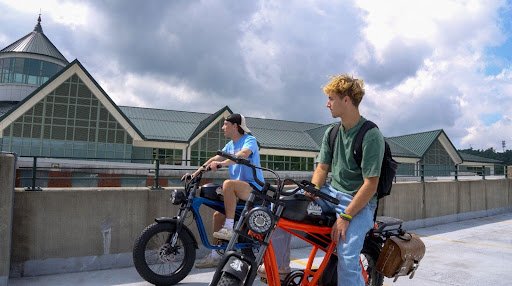Quick answer: Choose a Retro Electric Bike if you want style, weekend fun, and social vibes; pick a Commuter Electric Bike if you care most about daily efficiency, low upkeep, and predictable range. Both typically charge in about 4–6 hours from empty with a standard 2–3A charger, and real-world range often lands between 25–50 miles depending on battery size, terrain, and assist level. Below, I’ll show you how to match the bike to your lifestyle, break down the specs that matter, and share pro tips so you buy once and ride happy..
Retro Electric Bike: Who It’s For
The Retro Electric Bike blends vintage design with modern power—think round headlamp, tank-style top tube, and a plush saddle. If your rides double as self-expression—cruising to coffee, evening waterfront loops, and weekend meetups—this category shines. The upright or semi-moto posture keeps you relaxed, while thick tires and dual-crown looks (on some models) turn heads and smooth out bumps.
Why younger riders love it: the look has attitude, the style pops on camera, and the torque feels strong for short hops and hill starts. Many retro frames use moped-style geometry that feels planted and confident at city speeds. You’ll often get wider bars, cushier seats, and chunkier tires—features that trade a bit of pedaling efficiency for comfort and vibe.
Where it excels
- Short to medium city rides with frequent stops.
- Mixed surfaces—boardwalks, neighborhood streets, light paths.
- Social rides where looks and a relaxed cadence matter.
Trade-offs to consider
- Weight can be higher because of beefy frames and tires.
- Aerodynamics and pedaling efficiency are not the main focus.
- Mounting racks and panniers is possible on many models, but not always as tidy as a purpose-built commuter setup.
Commuter Electric Bike: Who It’s For
A Commuter Electric Bike puts practicality first: efficient geometry, lighter frames, and accessories (fenders, lights, racks) that make daily travel smooth. If you want to get from A to B quickly with minimal sweat and simple upkeep, this is the easy pick.
Why commuters love it: predictable range, simpler battery habits, and clean integration of the must-haves (rear racks for a work bag, full fenders for rainy mornings, integrated lights for early starts and late returns). You’ll typically see narrower tires, taller gearing, and a more neutral posture, which together improve energy use and stretch range at steady cruising speeds.
Where it excels
- Daily 5–20 mile round-trip commutes.
- Consistent, higher average speeds in bike lanes.
- Carrying a laptop pannier or small groceries with no drama.
Trade-offs to consider
- Less visual flair than retro/moto styles.
- A firmer ride on rough streets if the tires are narrow.
- Not as “photo-friendly,” if that is on your list.
Key Specs That Decide the Winner
To go from “vibe” to “decision,” line up these four pillars. Put your takeaways first: range and ergonomics drive about 70% of rider happiness. If either feels off, the honeymoon ends fast.
Battery & Range
What to look for: Watt-hours (Wh). More Wh means more miles. A 48V 15Ah pack ≈ 720Wh; at mixed PAS, plan on 25–45 miles.
Retro vs Commuter: Retro bikes often carry bigger batteries to balance extra weight and wide tires; commuters can go farther on less thanks to efficiency. If your route is mostly steady and flat, commuters stretch range better.
Motor & Assist Tuning
What to look for: Smooth PAS, solid hill torque, and a controller that does not surge.
Retro vs Commuter: Retro models sometimes lean into quick, moped-style takeoffs for fun. Commuters usually favor linear power for steady speeds and better battery use. Test PAS levels 1–3; if Level 1 already feels “too eager,” efficiency will take a hit.
Fit, Geometry & Comfort
What to look for: Reach, stack, saddle comfort, bar width, and tire volume.
Retro vs Commuter: Retro seats and bars can feel super comfy for short trips and stop-and-go rides. For longer runs at 18–22 mph, commuter geometry cuts fatigue and keeps cadence smooth.
Accessories & Everyday Use
What to look for: Racks, fenders, lights, kickstand stability, lock mounts, and charger placement.
Retro vs Commuter: Commuters win for out-of-the-box utility. Many retro models take racks and bags just fine—confirm mounting points if you plan to haul groceries or a laptop daily.
How to Make the Final Call (+Smart Charging & Range Tips)
Decision shortcut
Pick Retro Electric Bike if 70% of your riding is social, short-distance city cruising and you want maximum comfort and style.
Pick Commuter Electric Bike if 70% of your riding is Monday-to-Friday transit with a bag, in all weather, at steady speeds.
Charging time & battery life (what to expect)
- With a standard 2–3A charger, most packs go 0→100% in ~4–6 hours.
- To extend battery life, many riders charge from ~25–30% up to ~80–90% for daily use, with an occasional full charge to recalibrate the gauge.
- Cold temps cut range; store and charge at room temperature when you can.
Range math you can use today
- Start with 12–15 Wh per mile at moderate PAS on a commuter; plan 15–20 Wh per mile on a chunkier retro with knobby/wide tires.
- Example: a 720Wh battery gives ~48–60 miles on an efficient commuter and ~36–48 miles on a heavier retro, all else equal.
Fit test that prevents buyer’s remorse
- Ride 15 minutes at your expected commute speed. If your hands or lower back complain, that geometry is not your match.
- Try a few standing starts on an incline. Does power ramp smoothly, or does it surge? Smooth ramp = safer and friendlier to the battery.
Safety & control
Prioritize hydraulic disc brakes for urban traffic.
- Tires: 2.1–2.4″ commuter slicks roll fast; 3.0″+ retro tires soak bumps but sip more watt-hours.
- Lights: integrated front/rear boost visibility and reduce forgotten-light syndrome.
Putting It All Together (and where to start)
If your heart says “style” and your calendar says “weekends,” a Retro Electric Bike is the joy machine that will keep you riding more often. If your calendar says “weekdays” and your backpack rides shotgun, a Commuter Electric Bike is the calm, efficient partner that pays you back every single morning.
Either way, today’s e-bikes are dialed, so you do not have to trade build quality or safety to get the look you want. Start by writing down your top two must-haves (range vs. comfort, speed vs. cargo, style vs. utility), then test-ride with those in mind. When the fit disappears and the ride just flows, you have found your bike.

